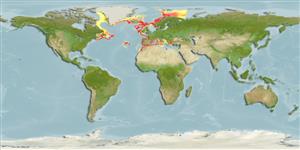Environment: milieu / climate zone / depth range / distribution range
นิเวศวิทยา
เกี่ยวกับทะเล,น้ำเค็ม สัตว์น้ำหน้าดิน; ไม่มีการอพยพย้ายถิ่น; ระดับความลึก 150 - 1000 m (Ref. 54594), usually 350 - 500 m (Ref. 54594). Temperate; 79°N - 29°N, 65°W - 44°E (Ref. 54594)
Northeast Atlantic: Southwestern Barents Sea, sometimes north to Spitsbergen, southeastern Greenland, southern coast of Iceland, around the British Isles and south to Morocco and into the western Mediterranean. Northwest Atlantic: Newfoundland.
Length at first maturity / ขนาด / น้ำหนัก / Age
Maturity: Lm 86.5 range ? - 88 cm
Max length : 155 cm TL เพศผู้/กระเทย; (Ref. 1371); น้ำหนักสูงสุดที่มีการรายงาน: 30.0 kg (Ref. 35388); อายุสูงสุดที่ได้รายงาน: 20 ปี (Ref. 1371)
เงี่ยงครีบหลัง (รวม): 0; เงี่ยงครีบก้น 0; ก้านครีบอ่อนที่ก้น: 70 - 81. Lower jaw longer than upper jaw; barbel shorter than eye diameter. Back gray-brown, grading to white ventrally. Posterior portions of vertical fins dark with pale margins.
Found mostly from 350-500 m depth on muddy bottoms. Feed on crustaceans and fish (flatfishes, gobies, rocklings) (Ref. 1371).
Cohen, D.M., T. Inada, T. Iwamoto and N. Scialabba, 1990. FAO species catalogue. Vol. 10. Gadiform fishes of the world (Order Gadiformes). An annotated and illustrated catalogue of cods, hakes, grenadiers and other gadiform fishes known to date. FAO Fish. Synop. 125(10). Rome: FAO. 442 p. (Ref. 1371)
IUCN Red List Status (Ref. 130435)
Threat to humans
Harmless
Human uses
การประมง: การค้า
ข้อมูลเพิ่มเติม
อ้างอิงการเพาะเลี้ยงสัตว์น้ำประวัติการเพาะเลี้ยงสัตว์น้ำสายพันธุ์พันธุศาสตร์ElectrophoresesอัตราพันธุกรรมโรคการแปรรูปNutrientsMass conversion
เครื่องมือ
Special reports
Download XML
แหล่งที่มาจากอินเตอร์เน็ต
Estimates based on models
Preferred temperature (Ref.
123201): 2.1 - 14.1, mean 6.3 °C (based on 199 cells).
Phylogenetic diversity index (Ref.
82804): PD
50 = 0.6250 [Uniqueness, from 0.5 = low to 2.0 = high].
Bayesian length-weight: a=0.00302 (0.00169 - 0.00538), b=3.03 (2.87 - 3.19), in cm total length, based on LWR estimates for this species & (Sub)family-body (Ref.
93245).
ระดับชั้นอาหาร (Ref.
69278): 4.5 ±0.6 se; based on diet studies.
ความสามารถในการกลับคืนสู่ปกติ (Ref.
120179): ต่ำ, เวลาต่ำสุดที่จะทำให้ประชากรเพิ่มขึ้นเป็น 2 เท่าใช้เวลา 4.5 - 14 ปี (K=0.13-0.16; tm=8-11; tmax=20).
Prior r = 0.35, 95% CL = 0.23 - 0.52, Based on 4 stock assessments.
Fishing Vulnerability (Ref.
59153): Very high vulnerability (75 of 100).
Climate Vulnerability (Ref.
125649): Moderate to high vulnerability (47 of 100).
Nutrients (Ref.
124155): Calcium = 16.4 [8.1, 35.6] mg/100g; Iron = 0.278 [0.142, 0.592] mg/100g; Protein = 17.6 [15.8, 19.3] %; Omega3 = 0.381 [0.204, 0.707] g/100g; Selenium = 29.8 [15.2, 59.6] μg/100g; VitaminA = 10.9 [2.7, 40.8] μg/100g; Zinc = 0.305 [0.198, 0.473] mg/100g (wet weight);
